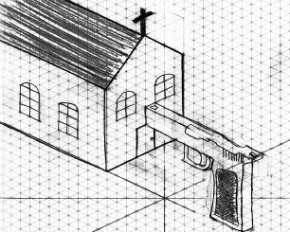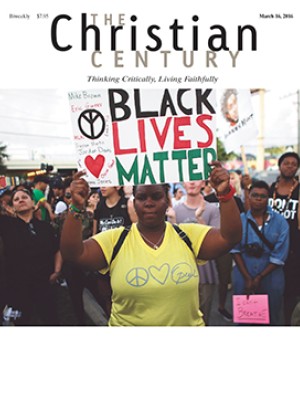
When my barber asked me if I believed that zombies were real, I laughed. “Zombies are on TV, movies, in books and games, but they’re not real.”
With agitation in her voice, my barber replied, “Well, my pastor preaches zombies are real. He says that the devil reinvigorates dead bodies and that’s what zombies are.”
“Where in the Bible does he get this?”
With more than a little indignation she said, “I don’t know. All I know is that zombies are real, and we better get our guns and our ammunition ready.”
The late Texas journalist Molly Ivins said, of watching Texas politics, “I used to laugh, cry, or throw up, and I got tired of crying and throwing up.” I’d say the same goes for much of Texas church life.
Zombies might be a laughing matter, but guns are not. Since January 1 in Texas, it is legal for licensed gun owners to openly carry a gun in public places, including church, unless the church posts signs at every entrance that say no to guns—and follows specific guidelines that dictate the wording on the sign.
For several years it’s been legal to carry concealed guns, but most of us didn’t pay much attention. The guns were “out of sight and out of mind,” and many of us clergy didn’t think we had to be concerned about guns in church. The idea seemed ludicrous. Now, with the open carry law in effect, there is considerable debate in congregations as well as workplaces and businesses. Guns are still banned from schools and hospitals, but not in many places where they were previously banned, including state universities and state mental health treatment centers. A class of first-graders touring the state capitol in Austin will wait in line as a security agent checks each child’s backpack. Then the child must go through a metal detector. Meanwhile, those who are licensed to carry a firearm are waived through, pausing only long enough to sign their name.
Read our latest issue or browse back issues.
Last year a church down the road from us voted—over the pastor’s strong disagreement—to arm the ushers. Now, as of January 1, the church’s ushers are no longer the only ones armed on Sunday morning. Clergy I’ve talked with assume that a considerable number of church attendees are carrying guns on any Sunday, and they say that most of the churches around town have declined to post signs. Several pastors told me that even the prospect of “No Guns” signs would spark a heated debate—one that supporters felt they would lose.
The rationale of gun-carrying church members is that they want to be ready to protect themselves and their families if an armed intruder enters the church. But with the new law in place, who will know if the person is an armed intruder or an armed visitor? And even if the person is not carrying a firearm openly, that person may still be armed. Therefore, all visitors are now scrutinized, with every visitor being a potential threat. At the same time, to demonstrate their enthusiasm for the new law, some churches are posting signs that say—as an act of outreach—“Guns Welcome Here.”
I’ve been astonished at the level of fear associated with perceived threats that are just outside our doors ready to get us. A close friend who is a dental hygienist and a devoted Catholic is considering going through handgun training so that she can become licensed to carry. As she says, “Who knows if someone might barge into the dental office and start shooting?” Down at the barbershop I’ve discovered that my barber is armed (zombies beware). Now I’m anxious about getting a haircut. Maybe I need a panic button like the ones that the church with the armed ushers installed throughout the building. Church members can sound an alarm if they feel threatened.
In my own congregation I underestimated the amount of fear about other people carrying guns. Over and over I’ve heard, “We don’t want guns and the church is not the place for them, but we’re in the spotlight because of other positions our church has taken. We’re afraid that the signs will be a magnet for people who want to make a pro-gun statement.” One member said, “The signs make a statement. If it was just me, I’d agree to posting them. But my whole family is here in church, including my new baby grandson, and I don’t mind telling you I’m afraid.” This is a congregation that’s made courageous stands for LGBTQ persons, against racism, and for peace in the midst of the Iraq war.
Not long ago a stranger walked into Sunday morning worship at our partner church in town, a distinguished African-American congregation. He was dressed in baggy clothes, carried a backpack, and was visibly agitated. Several deacons sat with him, then visited with him afterward. He needed help, which the church provided. But after his visit the deacons decided to sit at the back near the entrances, instead of in the front row.
Our own ushers are revising where and how they greet people, and we’re installing security cameras at each entrance. And, after a lot of congregational deliberation, we’re posting signs at every entrance—one against open carry and one against concealed carry.
My most recent barbershop conversation was about how many pastors in town are going through handgun training so they can pack a pistol—even on Sunday mornings in the pulpit. After asking around, I discovered that there are more preachers packing on Sunday mornings than not. I was dismayed.
I keep asking myself where the witness of Christ is in all of this. Many of the pastors who are carrying guns teach and preach a version of the gospel that’s different from what I know. It is a gospel of everyone looking out for himself or herself, a gospel that says, “It’s a dangerous world, so get them before they get you. I’m protecting me and mine, and furthermore it is God’s will and biblical teaching to do so.” Loving your neighbor as yourself, loving enemies, suffering servanthood, forgiveness, the Sermon on the Mount, living and dying like Jesus—I’m hearing much less about that.
One of my deacons, the dean at a nearby college, was in a faculty meeting listening to faculty members discuss how they were all getting guns. The dean said she refused to carry a gun. It got quiet in the room, then someone asked why. She said she was not prepared to shoot and perhaps kill someone. There was a long pause and then, “What would you do if someone threatening came into the classroom?” The dean said, “I’d tell them about Jesus and try to show them the love of Jesus.”
“You could hear a pin drop,” she told me later. “Everyone looked at the floor, and someone changed the subject.”
During a sermon on baptism a few weeks ago, I explained why I would not be carrying a gun in the pulpit or anywhere else. “It has to do with baptism,” I said. “When I went down into the waters of baptism, I did not come out to strap on a gun. I came out entering into the life of the crucified and resurrected Jesus Christ.” I went on, “In baptism our lives are no longer our own. We belong to Christ.” I could see and hear some crying in the congregation.
The next week it felt as if we’d crossed a threshold. We had a new energy in church. One dad with two young children in tow said, “I’m glad to know my pastor is not packing.” After the service a visitor with a graying ponytail and wearing a jeans jacket walked up and flipped open his jacket. “I’m clean,” he said. “I’m not carrying. Because of Jesus, I’m not carrying.” I embraced him.






